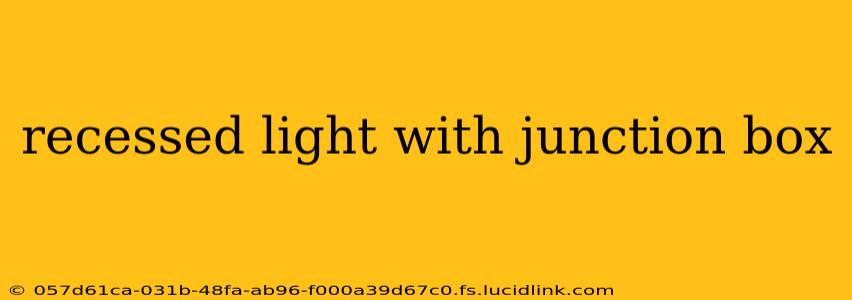Installing recessed lighting can dramatically improve your home's ambiance and functionality. However, understanding the crucial role of junction boxes is vital for a safe and effective installation. This guide explores everything you need to know about recessed lights and their connection to junction boxes, addressing common questions and providing valuable insights for both DIY enthusiasts and professional electricians.
What is a Junction Box and Why is it Necessary for Recessed Lighting?
A junction box is an electrical component that serves as a safe enclosure for wiring connections. In the context of recessed lighting, it's the central point where the power wires from your home's electrical system connect to the wires leading to the recessed light fixture. Its primary purpose is to protect these connections from damage, moisture, and accidental contact, preventing electrical hazards and ensuring the longevity of your lighting system. Using a junction box is crucial for compliance with electrical codes, guaranteeing safety and preventing potential fire hazards. Simply put, it's an essential safety measure you shouldn't overlook.
What Types of Junction Boxes are Suitable for Recessed Lighting?
Several junction box types are compatible with recessed lighting installations, each offering specific advantages:
- Old Work Boxes: Designed for installations in existing ceilings where no pre-existing box is present. These boxes are typically affixed to the ceiling joists or rafters using clamps or screws. They are commonly used during renovations or when adding new lights to an existing structure.
- New Work Boxes: Ideal for installations during new construction or when the ceiling is already open. These boxes are installed within the ceiling structure before the drywall is installed, offering a flush and clean finish.
- Remodel Boxes: These boxes are designed to be retrofitted into existing ceilings and offer a flexible approach for various ceiling types and installations.
Choosing the right type depends largely on the specific circumstances of your installation, the type of ceiling, and whether you're working with new or existing construction. Always select a box that is appropriately sized to accommodate the wiring and light fixture.
How to Wire a Recessed Light to a Junction Box?
Wiring a recessed light to a junction box requires a solid understanding of electrical safety procedures. If you are not comfortable working with electricity, it’s crucial to consult a qualified electrician. However, a simplified overview is provided below for informational purposes only:
- Turn Off the Power: Before starting any work, always turn off the power to the circuit at the breaker box.
- Prepare the Wires: Strip the insulation from the ends of the power wires (typically black, white, and bare copper ground wire) and the wires from the recessed light fixture. Make sure to follow the manufacturer's instructions carefully.
- Connect the Wires: Connect the wires according to the color-coding system: black (hot) to black, white (neutral) to white, and bare copper (ground) to bare copper. Use wire connectors to secure the connections firmly and ensure they are tightly fastened.
- Place Connections in the Box: Carefully place all the wire connections inside the junction box. Ensure that enough slack is present to avoid straining the wires.
- Secure the Box: Securely attach the junction box to the ceiling using the appropriate hardware.
- Install the Recessed Light: Mount the recessed light fixture to the junction box, following the fixture's installation instructions carefully.
- Turn on the Power: Once everything is securely connected, turn the power back on at the breaker box and test the light.
Disclaimer: This is a simplified explanation, and specific wiring methods might vary depending on the fixture and local electrical codes. Improper wiring can result in electrical hazards, so it is essential to follow all local codes and regulations.
What Size Junction Box Do I Need for Recessed Lighting?
The size of the junction box required depends on the number of wires and the volume of the wires and the fixture's wiring. Consult the National Electrical Code (NEC) for detailed requirements based on the specific number and type of wires to be installed. Underestimating the size of the junction box can result in violation of electrical codes and can create safety risks. Always use the correct size junction box to ensure proper installation and compliance.
Can I Use a Junction Box for Multiple Recessed Lights?
Yes, you can use a single junction box for multiple recessed lights, but this is typically limited to a specific number of fixtures, depending on the box's size and the volume of the wiring. The NEC dictates the maximum number of wires a given junction box can safely contain. Using a larger box allows for multiple fixture connections, but ensuring proper wiring is crucial. Overloading a junction box can lead to overheating and fire hazards. Carefully calculate the wiring volume to ensure compliance with local electrical codes before connecting multiple fixtures to a single junction box.
What if My Recessed Light Doesn't Have a Junction Box?
If your recessed light fixture lacks a pre-installed junction box, it's crucial to install one before connecting the light to your electrical system. Failing to do so poses significant safety risks and is against most electrical codes. Installing a correctly sized and appropriately mounted junction box is non-negotiable for safe and legal operation.
This guide provides a comprehensive overview of using junction boxes with recessed lighting. Remember to prioritize safety, always consult the NEC and your local electrical codes, and, if unsure, seek assistance from a licensed electrician. Proper installation ensures a safe, functional, and aesthetically pleasing lighting solution for your home.
